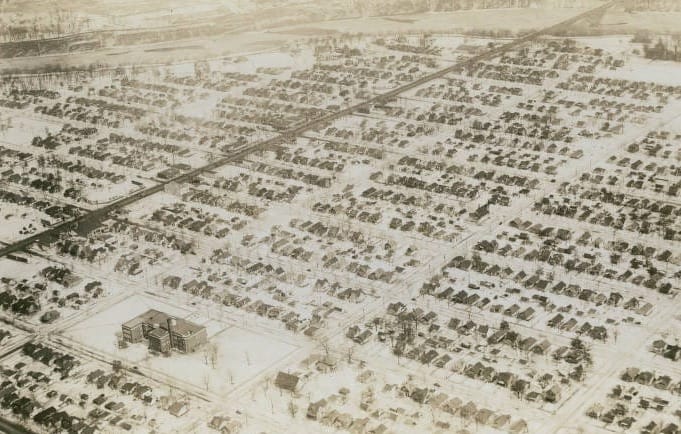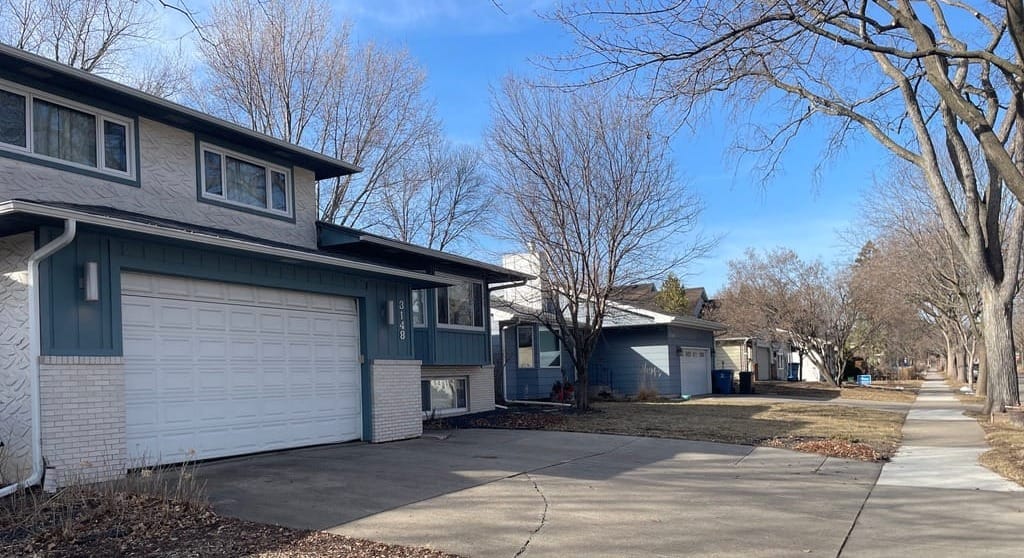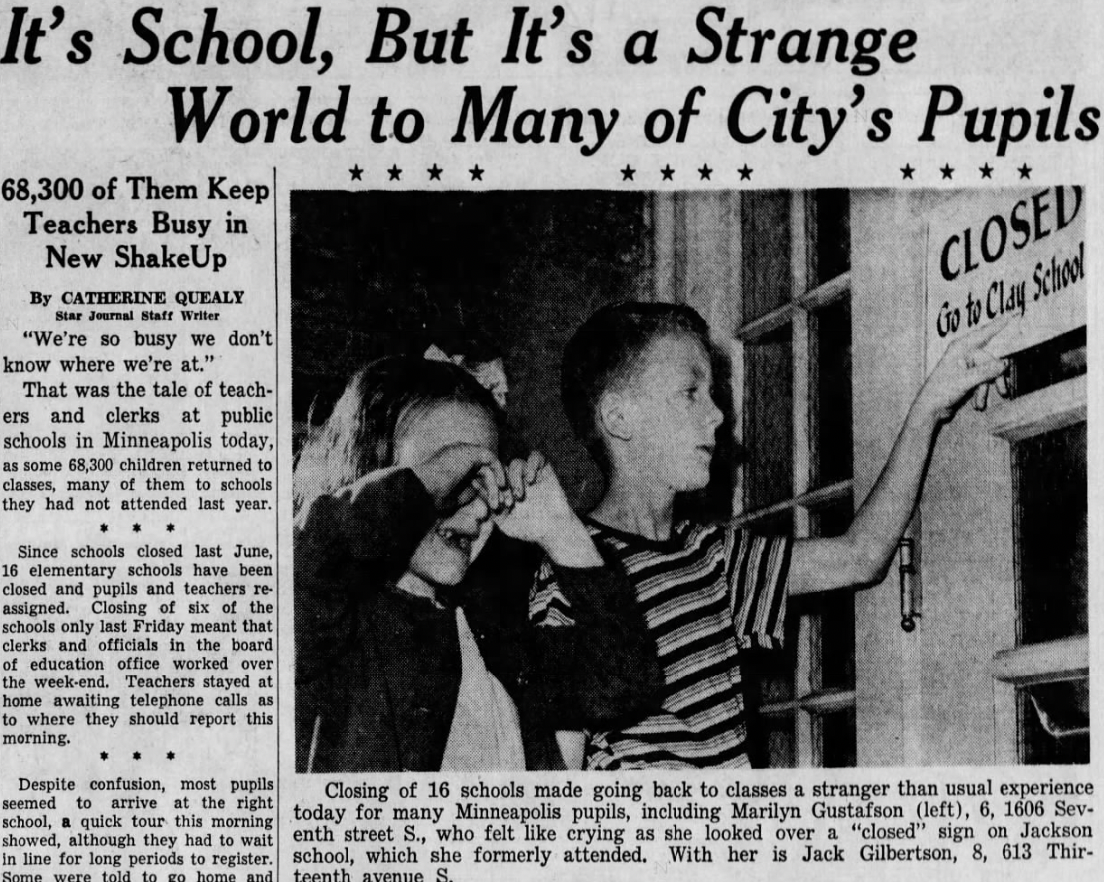🏘️ The case of the missing alley
Reader question: Why are the houses on the 3100 block of 37th/38th Avenue so much newer than the surrounding area?

Note: To celebrate our launch, this story is free for non-subscribers! To access everything else, become a subscriber.
Longfellow Whatever was recently tagged in a question on the Longfellow Social Facebook group (please keep those coming!): Why are the houses on the 3100 block of 37th/38th Avenue so much newer than the surrounding area, with their ranch-style architecture, attached garages, and missing alley?

The short answer, as a few commenters offered: The block used to be occupied by a schoolhouse. The building was torn down in the late '70’s and sold for single-family plots, upon which houses in the style of the day were built.
The longer version: Johnson Elementary was built on this block in 1910. It was the centerpiece of an area then known as Seven Oaks that was rapidly changing from dairy farms dotting the oak savannah into the blanket of single-family homes we know today. It was named for the state's first Minnesota-born governor, John A. Johnson, who loomed large in the public mind after unexpectedly dying in office the year prior. The handsome three-story brick building was similar in style to the Cooper (1923), Sanford (1926) and Howe (1927) schools built the following decade.

It served the growing population of families that filled in the subdivided farms over the next two decades. But enrollment across the city began to decline in the 1930's and by WWII, Minneapolis schools faced a dilemma that might sound familiar today: A lot of empty classrooms and a major budget deficit. The superintendent commissioned a study that proposed sweeping cuts and a solution that might also sound familiar today: closing schools.

This sparked a protracted fight with the 22 schools proposed for closure, who banded together under the banner of "Save Our Schools." That group was led by Johnson School PTA President and civically connected businessman W.A. Maney, who lived at 3448 36th Ave. across from Longfellow Park and ran Maney Brothers Mill & Elevator Co. on 22nd and Snelling in Seward.

Maney and company did the circuit of community meetings, door knocking, and lobbying. They collected more than 2,000 signatures for a ballot initiative to raise the school tax levy and avoid the closures. But the question was handily rejected at the polls and the closures proceeded.
Ultimately the school board settled on closing 16 elementary schools ahead of the 1942-1943 school year. Along with Johnson, two other Longfellow schools met their demise: Simmons Elementary (which still stands as an apartment building on 38th and Minnehaha) and Stowe Elementary on the 2800 block of 40th/41st Avenue (another block with noticeably newer homes). It was then the largest school closure in city history, though that would be surpassed in 1982 when the school board closed 17 schools during another period of declining enrollment and budget shortfall.
Adding to the sense of upheaval in 1942 was the fact that the school board didn't announce the final six closures until the Friday before the first day of school. According to the Minneapolis Star, “clerks and officials in the board of education office worked over the weekend. Teachers stayed at home awaiting telephone calls as to where they should report this morning.” Johnson's 238 students were variously transferred to Cooper, Howe, and Hiawatha.

In 1944 the school board leased the vacant building to the milling and chemical company Archer-Daniels-Midland Co. (ADM) for about $8,000 a month in today's dollars. After a few years of improved district enrollment fueled by the baby boom, the Board of Education briefly considered reopening the school in response to another petition from residents, but that never came to pass.
ADM — which still has a presence in the neighborhood as operator of the last-remaining flour mill in Minneapolis — used the Johnson School facility for a variety of industrial and agricultural research pursuits. Its paint lab, for instance, employed 18 paint chemists who developed "Arolon 110, the oil and water paint vehicle which disproved the old saying that the two won't mix."
After ADM moved its research facility to Bloomington in the early 1960's, North Star Research and Development took over the lease. An all-purpose research firm affiliated with the U, North Star pursued all manner of inquiry within the halls of the Johnson school: film for desalinating saltwater; a membrane for an artificial kidney machine; ultrasonic whistles for keeping mice out of grain silos; and various uses of newfangled computer technology.
Like ADM before it, North Star eventually decamped for the suburbs in 1976. The school board soon announced plans to demolish the building and sell the land as 20 single-family home lots (compared to the usual 28-30 on surrounding blocks).
Did this spark debate? Were there competing proposals for using the land? Was anybody mad? If so, it seems to be lost in the historical record. In '77 the school board awarded a demolition contract, by the spring of '78 aerial photos show the first homes being built, and by '83 the block was filled in with all but one of the homes we know today. All without mention in the local press, school board minutes, or city council archives.

Of course, this is well within living memory. Any 3100 blockers with stories to share? Comment or drop a line!